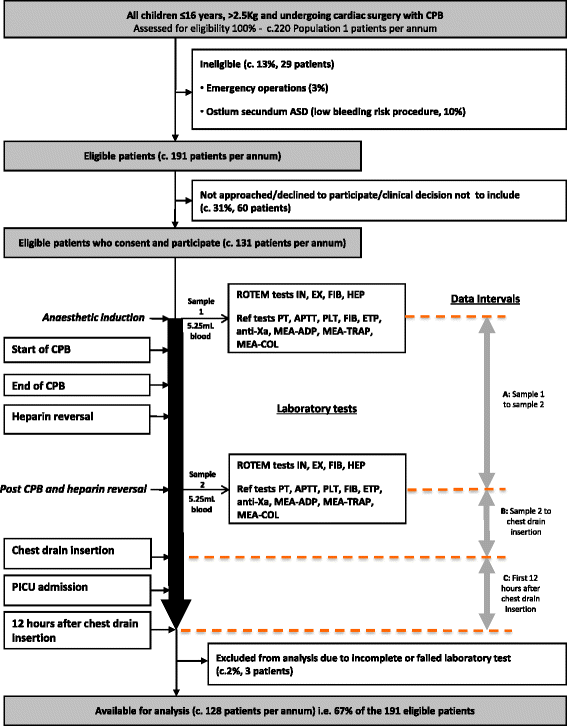Detection of coagulopathy in paediatric heart surgery [DECISION study]: study protocol
- PMID: 26301095
- PMCID: PMC4543490
- DOI: 10.1186/s12878-015-0030-8
Detection of coagulopathy in paediatric heart surgery [DECISION study]: study protocol
Abstract
Background: Each year in the UK, ≈3000 children undergo major cardiac surgery requiring cardiopulmonary bypass. Approximately 40 % of these experience excessive bleeding necessitating red cell transfusion or treatment with other blood components. A further 40 % receive blood components because of the perception by clinicians that the risk of bleeding is high. Excessive bleeding and treatment with red cell transfusion or blood components are associated with post-operative complications such as infection and renal injury and are independently associated with increased morbidity and mortality. Abnormalities in blood coagulation are a major cause of excessive bleeding after cardiac surgery in children. However, the extent of these abnormalities varies between children and their characteristics may change rapidly during surgery. In adults undergoing cardiac surgery, rapid testing of blood coagulation using techniques such as thromboelastometry may assist the selection of appropriate blood component treatments. In some sub-groups of adults, this improves clinical outcomes. Rapid testing of blood coagulation in children undergoing cardiac surgery has not been evaluated fully.
Methods/design: The DECISION study is a prospective, single-centre, observational study that aims to assess the utility of rapid testing of blood coagulation in children undergoing cardiac surgery. This will be achieved by testing blood samples from 200 children obtained immediately before, and after cardiac surgery. The blood samples will be analysed in parallel using thromboelastometry and reference laboratory tests of blood coagulation. The primary clinical outcome will be clinical concern about bleeding, defined as a composite of either excessive blood loss or the use of a pro-haemostatic treatment outside of standard treatment protocols because of perceived high risk of excessive bleeding. The reference laboratory test results will be used to describe the patterns of abnormalities in blood coagulation in children and will be compared to the thromboelastometry test results to determine the diagnostic accuracy of the thromboelastometry tests. We will estimate how well the reference and thromboelastometry test results predict clinical concern about bleeding.
Discussion: The DECISION study will identify the most useful thromboeastometry tests of blood coagulation for the prediction of excessive bleeding in children after cardiac surgery and will inform the design of future randomised controlled trials.
Trial registration: The trail was registered as ISRCTN55439761 on 23(rd) April 2015.
Keywords: Cardiopulmonary bypass; Coaugulation; Heart surgery; Paediatric; Rotational TEM; Thromboelastometry.
References
-
- New HV, Kelleher A, Arnold P, Ng C, Hennem S, Hall T, et al. A mulitcentre prospective observational survey of the perioperative use of blood components in paediatric cardiac surgery. Br J Haematol. 2011;153(supplement s1):11.
-
- Miller BE, Mochizuki T, Levy JH, Bailey JM, Tosone SR, Tam VK, et al. Predicting and treating coagulopathies after cardiopulmonary bypass in children. Anaesth Analg. 1997;85(6):1196–202. - PubMed
-
- Moganasundram S, Hunt BJ, Sykes K, Holton F, Parmar K, Durward A, et al. The relationship among thromboelastography, hemostatic variables, and bleeding after cardiopulmonary bypass surgery in children. Anaesth Analg. 2010;110(4):995–1002. - PubMed
LinkOut - more resources
Full Text Sources
Other Literature Sources
Miscellaneous


